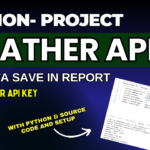
Placement Management System Using Python: Free Source Code and Guide
Building Placement Management System Using Python: Free Source Code and Guide
A Placement Management System is essential for colleges and universities to manage placement activities effectively. This system simplifies the process of student registration, company onboarding, job application tracking, and placement analytics. In this guide, we’ll walk you through building a Python-based Placement Management System that helps streamline these tasks. By the end of this post, you will have access to free source code for customization and deployment.
Table of Contents
Step 1: Making the Project
Begin by setting up a Python project using a web framework like Django or Flask. This system will include different user roles (admin, student, company) to manage placement processes efficiently. Here’s a breakdown of user roles:
- Admin: Manages student registrations, company details, and job postings.
- Students: Register, upload resumes, and apply for jobs.
- Companies: Register to post job openings and shortlist candidates.
Step 2: Essential Features
Here are the main features of the Placement Management System:
- Student Registration: Allow students to register and create profiles with their resume details.
- Company Registration: Enable companies to register and post job openings.
- Job Applications: Students can apply for job postings, and companies can shortlist candidates.
- Placement Analytics: Track placement statistics, including the number of placed students and available opportunities.

Step 3: Required Software and Tools
Before starting, ensure you have the following tools:
- Python 3.8+
- Django or Flask: A Python web framework for creating the backend of the system.
- SQLite or MySQL: A database to manage user and placement data.
- HTML/CSS/JavaScript: For building the frontend of the application.
- Complete Python Course : Click here
- Free Notes :- Click here
- New Project :-https://www.youtube.com/@Decodeit2
- Java Projects – Click here
Step 4: Running the Project
To run the Placement Management System, follow these steps:
- Install Dependencies: Install the required libraries by running
pip install -r requirements.txt- Run Migrations: Set up the database and tables by running migrations:
python manage.py makemigrationspython manage.py migrate- Run the Application: Start the Django development server
python manage.py runserver
Step 5: Project Screenshots
The following screenshots demonstrate different sections of the Placement Management System:
- Student Dashboard: Manage profile, view job postings, and apply for jobs.
- Company Interface: Post job openings and manage applicants.
- Admin Panel: Manage students, companies, job postings, and track placement data.

Step 6: Download the Project
Download the full source code for the Placement Management System from the
- Tags: Python, Placement Management, Django, Flask, Student Registration, Company Registration, Job Applications, Placement Analytics, Python Project.
- SEO Keywords: Python Placement Management System, Django Placement Portal, Placement Management System Python, Job Application System Python, Free Placement Management Source Code.
The Placement Management System is a crucial tool for managing student placements efficiently. By utilizing this Python-based system, you can handle everything from student registrations to job postings and placement tracking. Follow this guide, download the source code, and customize the system according to your institution’s needs. Get started today and streamline your placement process!
















1 comment